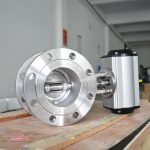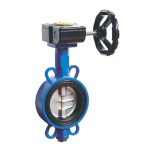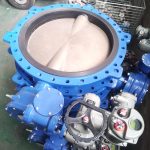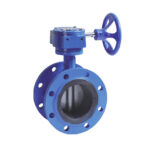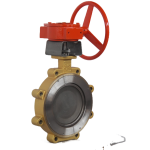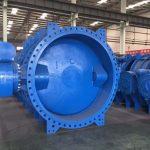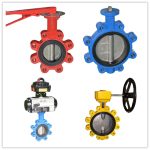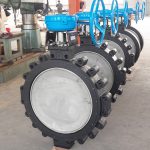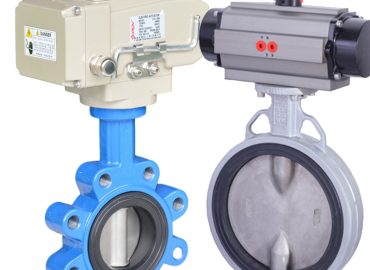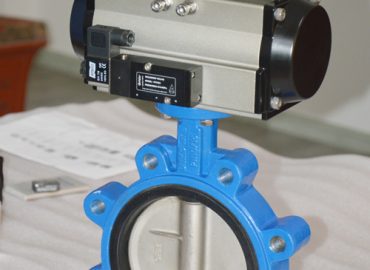Butterfly valves are widely used in various industries for regulating and controlling fluid flow. However, in some applications, they must operate in extreme temperature environments, where the materials used for their manufacturing may degrade or perform poorly. Double flanged butterfly valves have become popular in these applications due to their unique design and material properties. In this article, we explore how double flanged butterfly valves perform in extreme temperature environments, the advantages and disadvantages of using them, and how proper maintenance and care can ensure optimal performance in such conditions.
Introduction
Flanged butterfly valve are designed to perform well in extreme temperature environments where other valve types can fail. Unlike other valve designs that may experience warping, degradation, or sealing issues, double flanged butterfly valves are made with specific materials that can withstand high temperatures. These materials can be anything from stainless steel to exotic alloys, depending on the specific temperature range and environmental factors. Research has shown that double flanged butterfly valves can perform well in temperatures ranging from -50°C to 1300°C. In environments where temperature fluctuations are frequent, double flanged butterfly valves can provide reliable and consistent performance.
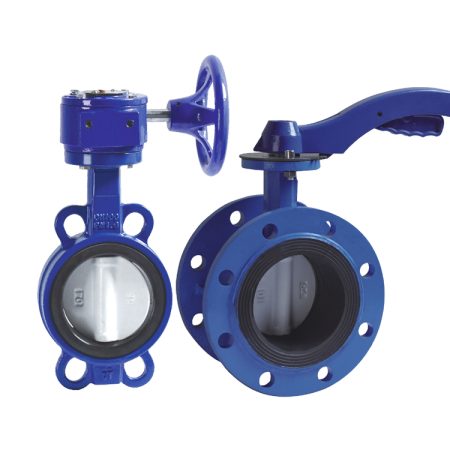
Explanation of butterfly valves and their application in various industries
U type Butterfly valve are vital in regulating and controlling fluid or gas flow in various industries such as chemical, water treatment, pharmaceuticals, and other processing plants. These valves are used to isolate, regulate, and control the flow of liquids, gases, and slurries in pipelines. Butterfly valves derive their name from their shape, which is similar to a butterfly, and their unique design allows for more precise control over flow rates. They are known for their lightweight, compact design, easy installation, and low cost compared to other valve types. Additionally, their low profile design minimizes space requirements and reduces the overall weight of the piping system, making them ideal in applications where space is limited. The versatility, economy, and reliability of butterfly valves make them a popular choice in various industries.
Brief explanation of double flanged butterfly valve
Double flanged butterfly valves are a type of butterfly valve that has flanges bolted to the valve body on both sides. This design ensures a double sealing effect, giving them better sealing performance in high-pressure applications. They are usually larger in size and used in applications with severe conditions that require high-pressure ratings. The double flanged design allows for easy installation and maintenance, and when used with appropriate materials, they offer excellent performance and durability in extreme temperature environments. Furthermore, the double flanged design feature can help in reducing fluid losses, making these valves useful in environments where leakage is not allowed.
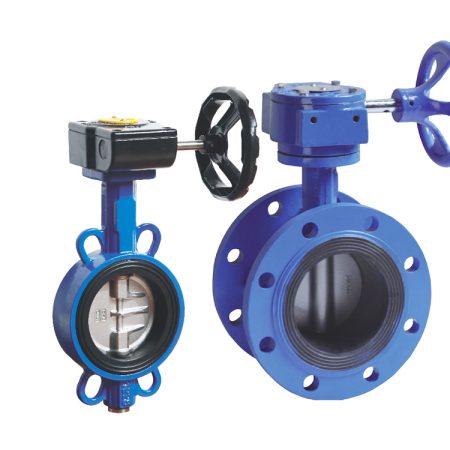
What are double flanged butterfly valve?
Double flanged butterfly valves are designed to provide better sealing performance and higher-pressure ratings compared to other butterfly valve types. These valves have a unique design that includes flanges bolted on both sides of the valve body, providing double sealing effects. This design reduces the chances of fluid leaks, making them ideal for high-pressure and severe environments where leakage is prohibited. Double flanged butterfly valves come in various sizes and are available in different materials depending on the temperature range and environmental factors of the application. Overall, their design and material properties make them a popular choice for regulating fluid and gas flow in different industries.
Definition and explanation of double flanged butterfly valves
Double flanged butterfly valves are a type of lug butterfly valve that has two flanges bolted to the valve body on both sides. These flanges offer a double sealing effect, providing better sealing performance for high-pressure applications. The double flanged design maintains the valve’s stability in pipelines and compensates for thermal expansion, reducing the need to support the valve separately. The valve’s butterfly disc is mounted on a stem and rotates 90 degrees to control the flow of fluid, making it easy to open and close when needed. The valve’s unique design allows for easy installation and maintenance, and it is available in various materials to withstand extreme temperatures and environmental conditions. Overall, the double flanged butterfly valve is a reliable, durable, and efficient solution for regulating fluid and gas flow in various industries.
Advantages and disadvantages of double flanged butterfly valves
Double flanged butterfly valves offer numerous advantages over other types of valves in high-pressure applications. Their design provides double sealing, reducing fluid leaks, and making them ideal for severe environments. Additionally, their lightweight and compact structure allows for easy installation and reduces the system’s overall weight, making them popular in applications where space is limited. Double flanged butterfly valves are also relatively inexpensive and require less maintenance than other valve types, ultimately reducing maintenance costs. However, their main disadvantage is their limited temperature range. Some models do not perform well in temperatures above 400°F, which may require the use of more expensive materials. Additionally, over time, their seals can be prone to wear and tear, requiring regular maintenance to ensure proper sealing performance. Overall, the advantages of double flanged butterfly valves often outweigh their disadvantages, making them a popular choice in various high-pressure applications.
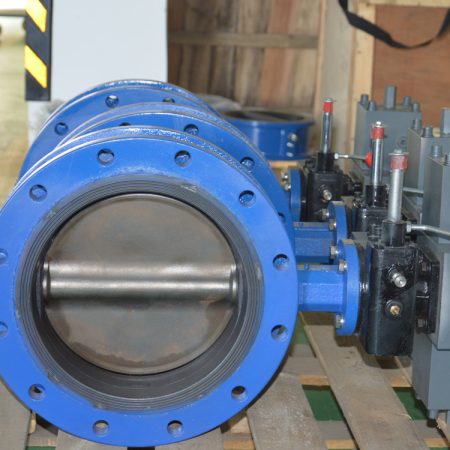
What is an extreme temperature environment for a valve?
An extreme temperature environment for a valve is a condition where the temperature is either too high or too low and exceeds the valve’s recommended temperature range. The temperature can have a significant impact on a valve’s performance and materials. High temperatures can cause thermal expansion or contraction, leading to valve distortion or failure. Low temperatures, on the other hand, can cause materials to become brittle, making them prone to breakage. Industries such as chemical, oil and gas, and power generation are examples of industries that require valves to perform in extreme temperature environments. Valves used in these industries must be carefully selected to ensure optimal performance and safety in such harsh conditions.
Explanation of criteria for extreme temperature environments
Criteria for extreme temperature environments refer to a range of operating temperatures that may cause valve materials to degrade, warp, or perform poorly. The criteria for an extreme temperature environment for a valve depend on the valve’s manufacturing materials, application, and environmental factors. The valve materials used must be capable of withstanding high or low temperatures and resist corrosion, erosion, and wear. Additionally, valve selection depends on the medium that flows through it. For example, in chemical plants, the type of chemical that flows through the valve affects the selection of materials for the valve’s manufacturing. Environmental factors such as vibration, shock load, wind, and weather conditions can also affect valve materials and, consequently, valve performance. Careful consideration of these criteria is essential when selecting valves for extreme temperature environments, ensuring optimal performance, efficiency, and safety in those conditions.
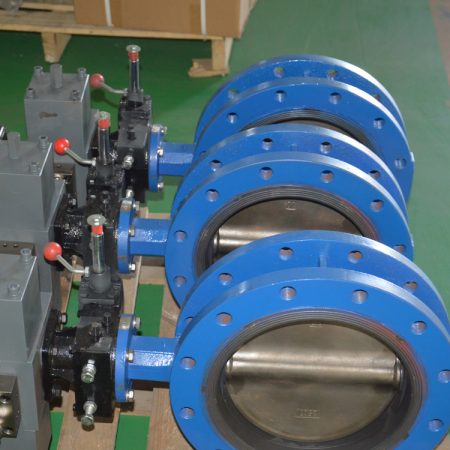
Examples of industries that require valves to work in extreme temperatures
Several industries require valves to perform in extreme temperature environments. One example is the chemical industry, where valves must withstand high-temperature environments and corrosive chemicals. The oil and gas industry is another example, where valves must operate in high-pressure and high-temperature environments, particularly in drilling applications. In power generation, valves must perform in high-temperature and high-pressure environments, particularly in steam generation plants. The aerospace industry is another example, where valves must perform in low-temperature environments, particularly in space applications. In summary, any industry that processes substances at high or low temperatures, either in liquid or gaseous form, will require valves that can perform optimally in extreme temperature environments.
How do double flanged butterfly valve perform in extreme temperature environments?
Double flanged butterfly valves are designed to withstand and perform well in extreme temperature environments. They are constructed with specific materials such as stainless steel, and exotic alloys that can withstand high temperatures, ensuring that they maintain their functionality in harsh environments. Research has shown that double flanged butterfly valves can perform efficiently in temperatures ranging from -50°C to 1300°C, which makes them ideal for use in various industries that require them to operate in extreme temperature conditions. Additionally, the double sealing effect provided by the valve’s design makes them an excellent choice for high-pressure applications where leakage is not allowed. Despite their excellent performance in extreme temperature environments, periodic valve maintenance will ensure that they continue to operate optimally, hence reducing the likelihood of failure over time.
Description of materials used for manufacturing double flanged butterfly valve
The materials used for manufacturing butterfly valves are chosen based on the specific temperature range and environmental factors of the application. Typically, the valve body is made of materials such as stainless steel, aluminum, or ductile iron. For high-temperature applications, materials such as Inconel, monel, and Hastelloy are used due to their excellent heat-resistant properties. The valve seat and disc are made of materials such as Teflon, neoprene, or EPDM that can provide optimal sealing performance in a wide range of temperatures. The stem is usually made of stainless steel and coated with nickel or chrome to enhance its durability and performance in various environments. Industries such as oil and gas, chemical, and power generation require valves that can withstand harsh operating conditions and are carefully selected according to the specific needs of the application.
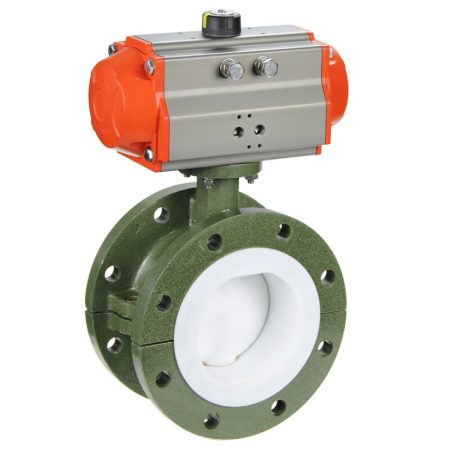
Comparison of the performance of different materials in extreme temperature environments
Different materials have varying performance when exposed to extreme temperature environments. For instance, stainless steel alloys have excellent performance in high-temperature environments and are resistant to corrosion and oxidation, making them popular in the oil and gas industry. Inconel, on the other hand, has excellent resistance to high-temperature corrosion, making it ideal for high-temperature environments in chemical processing plants. Titanium is ideal for applications with extremely low temperatures, such as aerospace and marine applications, due to its ability to withstand thermal shock and high strength-to-weight ratio. However, exotic materials like Inconel and titanium are more expensive compared to standard materials like stainless steel or aluminum. Ultimately, the choice of materials depends on the specific temperature range, application, and environmental factors, with careful consideration of factors such as material cost and availability, required system upkeep, and compatibility with the media flowing through the valve.
Benefits of using double flanged butterfly valves in extreme temperature environments
Using double flanged butterfly valves in extreme temperature environments comes with a multitude of benefits. Their unique flanged design offers double sealing, reducing the likelihood of fluid leakage in high-pressure applications, which is crucial in enhancing the safety and efficiency of the system. Double flanged butterfly valves are lightweight, compact, and require minimal maintenance compared to other types of valves. They are also available in various materials that can withstand harsh operating conditions and still offer optimal performance. Their ease of installation and maintenance makes them an attractive choice for industries that require valves that can operate in severe conditions, where frequent check-ups or repair processes could be challenging. In summary, the materials used for manufacturing double flanged butterfly valves and their unique design make them an ideal choice for performing efficiently and reliably in extreme temperature environments.
Explanation of the factors that make double flanged butterfly valves ideal for use in extreme temperature environments
Double flanged butterfly valves are an ideal choice for extreme temperature environments due to their unique design and construction. One factor that makes them well-suited for this purpose is their ability to handle both high and low temperatures without compromising performance. Additionally, the valve’s flanged design provides a secure sealing mechanism that minimizes the risk of leakage or damage to the valve body. This is crucial in extreme environments, as leaks can cause serious safety hazards or even system failures. The valve’s slim profile also makes it easier to install in tight spaces, which can be especially important in industrial settings where space is at a premium. Finally, the valve’s durability and long lifespan make it a reliable choice for high-temperature applications, reducing the need for frequent maintenance or replacement.
Discussion of the benefits of using these valves in such conditions
Using double flanged butterfly valves in extreme temperature environments can offer several benefits. For instance, the valves’ ability to withstand high and low temperatures makes them a versatile solution for different applications. Their secure sealing mechanism can prevent leakages and reduce the risk of damage to the valve, which could ensure safety and reliability in critical systems. Additionally, butterfly valves’ slim profile makes them easier to install in tight spaces, which can help save on installation costs and space. Their durability can reduce the need for frequent maintenance, lowering operating costs and improving overall efficiency. Finally, butterfly valves’ cost-effectiveness makes them a practical choice for many industrial applications where high temperatures are present, saving on overall operational expenses.
Maintenance and upkeep of double flanged butterfly valves in extreme temperature environments
Proper maintenance and upkeep of butterfly valves in extreme temperature environments are essential to ensure their optimal performance and longevity. Regular inspections are necessary to identify any signs of damage or wear such as corrosion, deformation, or leaks. Cleaning and lubricating the valve’s components can also help prevent buildup and ensure smooth operation. In addition, it is crucial to replace any damaged or worn out parts promptly to prevent further damage and maintain the valve’s integrity. It is also important to use the appropriate materials and lubricants suitable for the valve’s operating temperature range to ensure maximum performance in extreme temperature environments. Regular testing and supervision of the valve’s operation can help detect any malfunctions or issues and enable prompt action to prevent any damage or safety hazards.
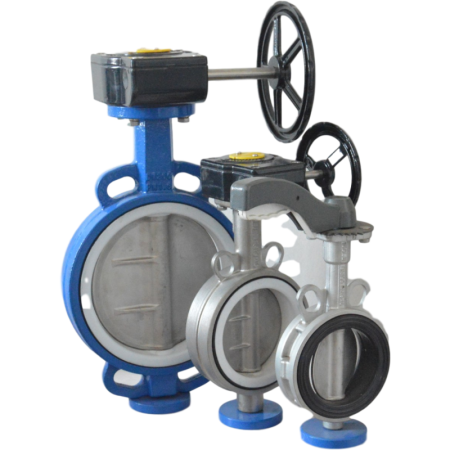
Explanation of proper maintenance and care for double flanged butterfly valves to ensure optimal performance in extreme temperatures
Proper maintenance and care are crucial to ensure maximum performance and longevity of double flanged butterfly valves in extreme temperature environments. Some of the essential maintenance practices include regular cleaning and lubrication of the valve’s components to prevent buildup and ensure smooth functioning. It is also crucial to inspect the valve regularly for any signs of wear and tear such as deformation, cracks, or leaks. Replacing damaged or worn-out parts promptly can prevent further damage and ensure the integrity of the valve. In addition, using appropriate materials and lubricants for the operating temperature range of the valve is crucial to avoid degradation of the performance of the valve. Regular testing and monitoring of the valve’s operation can help detect any issues or malfunctions promptly, leading to quick solutions and preventing damage or hazards. Finally, following the manufacturer’s instructions on maintenance and care procedures can also ensure optimal performance and safety of the valve in extreme temperature environments.
Conclusion
In conclusion, double flanged butterfly valves can perform exceptionally well in extreme temperature environments due to their unique design and construction. By effortlessly handling high and low temperatures while maintaining their reliability and performance, they offer an ideal solution for various industrial applications where high temperatures are present. Moreover, their flanged design provides a secure sealing mechanism that significantly reduces the risk of leakage and damage to the valve body, which is crucial for safety and efficiency in extreme environments.
However, to ensure optimal performance and extend the lifespan of double flanged butterfly valves in extreme temperature environments, proper maintenance and care are essential. Regular inspections, cleaning, lubrication, and replacement of worn-out parts are necessary to maintain their integrity and performance. Following the manufacturer’s instructions on maintenance and care, procedures can also improve safety and prevent any hazards.
Overall, double flanged butterfly valves can provide several benefits, including cost-effectiveness, durability, reliability, and versatility, making them a practical choice for many industrial and extreme temperature applications. As technology advances, more advanced materials, designs, and construction methods will continue to enhance their capabilities, making them even more efficient and reliable in the future.
Recap of double flanged butterfly valves’ performance in extreme temperature environments
To recap, double flanged butterfly valves are an ideal solution for extreme temperature environments due to their ability to handle high and low temperatures while maintaining superior performance and reliability. Their flanged design provides a secure sealing mechanism that minimizes the risk of leakage and damage to the valve body, offering enhanced safety and efficiency in extreme environments. Proper maintenance, cleaning, and care are essential to ensuring their optimal performance and longevity, which includes regular inspections, replacement of worn-out components, and lubrication. In summary, their versatility, cost-effectiveness, durability, reliability, and easy installation make them a practical choice for many industrial and extreme temperature applications. When maintained and cared for correctly, double flanged butterfly valves can continue to provide excellent performance and service for many years.
Final thoughts on the importance of selecting the right valve for extreme temperature environments
Selecting the right valve for extreme temperature environments is crucial for safety, efficiency, and optimal performance. Using the wrong type of valve or one that is not designed or manufactured to handle the specific temperature range and conditions can have severe consequences, such as leaks, malfunctions, system failures, and safety hazards. Therefore, it is essential to select valves that are specially designed for these environments, and ones that have been tested and certified to meet the required standards. Understanding the application requirements and consulting with qualified professionals can help in selecting the right valve for specific extreme temperature environments to ensure their optimal performance and longevity. Ultimately, selecting the right valve can contribute to an overall safer, more efficient, and cost-effective system.



